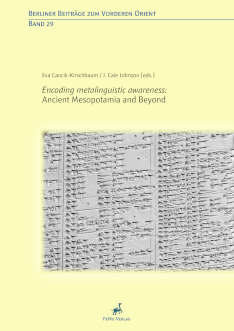
E. Cancik-Kirschbaum/J.C. Johnson(eds.)
Encoding metalinguistic awareness: Ancient Mesopotamia and Beyond.
Berliner Beiträge zum Vorderen Orient, Band 29
Format: 24,5 x 17,5 cm — Hardcover
Umfang: 226 Seiten
ISBN: 978-3-935012-40-9
Preis: 33,80 €
© PeWe-Verlag 2019
Mit Beiträgen von P. Delnero, J.C. Johnson, E. Cancik-Kirschbaum, I. Hajnal, A. Payne, J.S. Pettersson, F. Rochberg, L. Wilhelmi und M. Worthington.
Die Keilschrifttexte (Mesopotamien, heutiger Irak, 3300 v. Chr. – 200 n. Chr.) gelten seit langem als eines der vielversprechendsten Gebiete für die Geschichte der Notation und bieten eine riesige Auswahl an Textartefakten, die sich direkt auf Fragen der metasprachlichen Funktion und des metapragmatischen Bewusstseins beziehen.
Encoding Metalinguistic Awareness: Ancient Mesopotamia and Beyond enthält neun Beiträge von führenden Spezialisten über die Art und Weise, wie die Keilschrift und benachbarte Schriftsysteme sowohl metalinguistische als auch metapragmatische Informationen und Funktionen kodieren. Dieser Band geht einer Reihe von drängenden Fragen nach: Wie identifizieren Teile eines schriftlichen Textes die Gattung oder kontextualisieren andere Teile? Inwieweit lassen sich die Kategorien, die die Menschen des Altertums auf ihre Welt angewandt haben, in semantischen Determinativen wiedererkennen? Wie können erstarrte Silbenschriften quasi-logografische Funktionen übernehmen? Wie können wir unterschwellige linguistische Merkmale nutzen, um schriftliche Texte in einem chronologischen Rahmen zu verorten?
Dies sind nur einige der Fragen, die in diesem Band behandelt werden, einem Band, der die jüngsten Forschungen zusammenfasst und auch eine Reihe neuer Hypothesen zur Geschichte des notationsgesteuerten Bewusstseins im Alten Orient und im östlichen Mittelmeerraum der Antike vorschlägt.
With contributions by P. Delnero, J.C. Johnson, E. Cancik-Kirschbaum, I. Hajnal, A. Payne, J.S. Pettersson, F. Rochberg, L. Wilhelmi and M. Worthington.
Long recognised as one of the most promising arenas for the history of notation, the cuneiform textual record (Mesopotamia, present-day Iraq, 3300 BCE–200 CE) offers a massive array of text-artifactual materials that speak directly to questions of metalinguistic function and metapragmatic awareness.
Encoding Metalinguistic Awareness: Ancient Mesopotamia and Beyond includes nine papers from leading specialists on the ways in which cuneiform and neighbouring writing systems encode both metalinguistic and metapragmatic information and function. This volume delves into a host of pressing questions: how do parts of a written text identify the genre or contextualise other parts? To what degree can be recognise the categories that the ancients applied to their world in semantic determinatives? How can frozen syllabic writings take on quasi-logographic functions? How can we use below-the-radar linguistic features to locate written texts in a chronological framework?
These are just a few of questions dealt with in this volume, a volume that summarises recent research and also proposes a host of new hypotheses for the history of notation-driven awareness in the ancient Near East and the Eastern Mediterranean in antiquity.